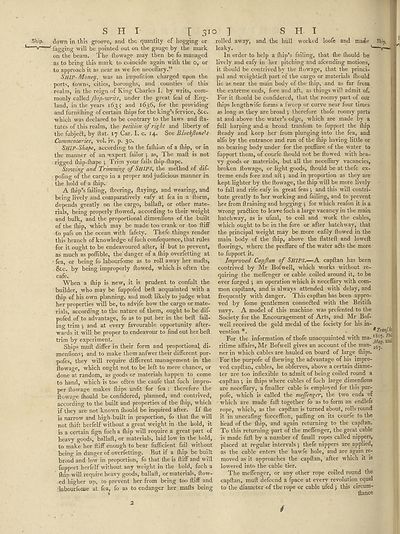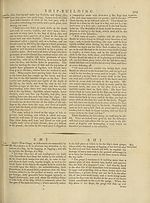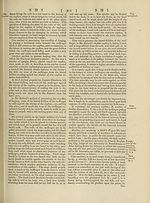Encyclopaedia Britannica, or, a Dictionary of arts, sciences, and miscellaneous literature : enlarged and improved. Illustrated with nearly six hundred engravings > Volume 19, Scripture-SUG
(352) Page 310
Download files
Complete book:
Individual page:
Thumbnail gallery: Grid view | List view

SHI t 310 1
down in tills groove, and the quantity of hogging or rolled away,
lagging will be pointed out on the gauge by the mark
on the beam. The ftowage may then be fo managed
as to bring this mark to coincide again with the o, or
to approach it as near as we fee neceflary.”
SHIP-Money, was an impolition charged upon the
ports, towns, cities, boroughs, and counties of this
realm, in the reign of King Charles I. by writs, com¬
monly called Jhip-writt, under the great feal of Eng¬
land, in the years 163 5 and 1636, for the providing
and furniftiing of certain Ihipsfor the king’s fervice, &c.
which was declared to be contrary to the laws and fta-
tutes of this realm, the petition of right and liberty of
the fubjeft, by itat. 17 Car. I. c. 14. See Bluckjlone-s
Commentaries, vol. iv. p. 30.
SHIP-Shape, according to the fafhion of a Ihip, or in
the manner of an “expert failor ; as, I he malt is not
rigged Ihip-lhape ; Trim your fails Ihip-lhape.
Stowing and Trimming of SHIPS, the method of dif-
poling of the cargo in a proper and judicious manner in
the hold of a Ihip.
A (hip’s failing, fleering, flaying, and wearing, and
being lively and comparatively eafy at fea in a ftorm,
depends greatly on the cargo, ballaft, or other mate¬
rials, being properly flowed, according to their weight
and bulk, and the proportional dimenfions of the built
of the Ihip, which may be made too crank or too ftiff
to pafs on the ocean with fafety. Thefe things render
this branch of knowledge of fuch confequence, that rules
for it ought to be endeavoured after, if but to prevent,
as much as poflible, the danger of a Ihip overfetting at
- fea, or being fo labourfome as to roll away her marts,
See. by being improperly flowed, which is often the
cafe. v
When a (hip is new, it is prudent to confult the
builder, who may be fuppofed beft acquainted with a
Ihip of his own planning, and moft likely to judge what
her properties will be, to advife how the cargo or mate¬
rials, according to the nature of them, ought to be dif-
pofed of to advantage, fo as to put her in the beft fail¬
ing trim •, and at every favourable opportunity after¬
wards it will be proper to endeavour to find out her.beft
trim by experiment.
Ships muft differ in their form and proportional di-
menfions*, and to make them anfwer their different pur-
pofes, they will require different management in the
ftowage, which ought not to be left to mere chance, or
done at random, as goods or materials happen to come
to hand, which is too often the caufe that fuch impro¬
per ftowage makes Ihips unfit for fea : therefore the
ftowage fhould be confidered, planned, and contrived,
according to the built and properties of the {hip, which
if they are not known ftiould be inquired after. If (lie
is narrow and high-built in proportion, fo that (he will
not fluff herfelf without a great weight in the hold, it
is a certain fign fuch a (hip will require a great part of
heavy goods, ballaft, or materials, laid low in the hold,
to make her ftiff enough to bear fufficient fail without
being in danger of overfetting. But if a (hip be built
broad and low in proportion, fo that the is ftiff and will
fupport herfelf without any weight in the hold, fuch a
{hip will require heavy goods, ballaft, or materials, flow¬
ed higher up, to prevent her from being too ftiff and
labourfome at fea, fo as to endanger her marts being
SHI
and the hull worked
loofe and made Shm
leaky.
In order to help a {hip’s failing, that (he ftiould be
lively and eafy in her pitching and afeending motions,
it Ihould be contrived by the ftowage, that the princi¬
pal and weightieft part of the cargo or materials fhould
lie as near the main body of the (hip, and as far from
the extreme ends, fore and aft, as things will admit of.
For it ihould be confidered, that the roomy part of our
{hips lengthwife forms a fweep or curve near four times
as long as they are broad *, therefore thofe roomy parts
at and above the water’s edge, which are made by a
full harping and a broad tranfom to fupport the ihip
fteady and keep her from plunging into the fea, and
alfo by the entrance and run of the fhip having little or
no bearing body under for the preffure of the water to
fupport them, of courfe Ihould not be flowed with hea¬
vy goods or materials, but all the neceffary vacancies,
broken ftowage, or light goods, Ihould be at thefe ex¬
treme ends fore and aft; and in proportion as they are
kept lighter by the ftowage, the {hip wull be more lively
to fall and rife eafy in great feas ; and this will contri¬
bute greatly to her working and failing, and to prevent
her from {training and hogging *, for which reafon it is a
wrong practice to leave fuch a large vacancy in the main
hatchway, as is ufual, to coil and wrork the cables,
which ought to be in the fore or after hatchway, that
the principal weight may be more eafily flowed in the
main body of the fhip, above the flatteft and loweft
floorings, where the preffure of the water afts the more
to fupport it.
Improved Capfan of SHIPS.—A capftan has been
contrived by Mr Bofwell, which works without re¬
quiring the meffenger or cable coiled around it, to be
ever forged an operation v'hich is neceffary with com¬
mon capftans, and is always attended with delay, and
frequently with danger. This capftan has been appro¬
ved by fome gentlemen connected with the Britifo
navy. A model of this machine was prefented to the
Society for the Encouragement of Arts, and Mr Bof¬
well received the gold medal of the fociety for his in¬
vention *. - &Tranf.h
For the information of thofe unacquainted with ma-1^°7- ^ ^
ritime affairs, Mr Bofwell gives an account of the man- 26^’
ner in which cables are hauled on board of large {hips.
For the purpofe of {hewing the advantage of his impro¬
ved capftan, cables, he obferves, above a certain diame¬
ter are too inflexible to admit of being coiled round a
-capftan *, in {hips where cables of fuch large dimenfions
are neceffary, a fmaller cable is employed for this pur¬
pofe, which is called the meffenger, the two ends of
which are made fall together fo as to form an endlefs
rope, which, as the capftan is turned about, rolls round
it in unceafing fucceflion, parting on its courfe to the
head of the {hip, and again returning to the capftan.
To this returning part of the meffenger, the great cable
is made faft by a number of fmall ropes called nippers,
placed at regular intervals ; thefe nippers are applied,
as the cable enters the hawfe hole, and are again re¬
moved as it approaches the capftan, after which it is
lowered into the cable tier.
The meffenger, or any other rope coiled round the
capftan, muft defeend a {pace at every revolution equal
to the diameter of the rope or cable ufed 3 this circum-
ftance
2
down in tills groove, and the quantity of hogging or rolled away,
lagging will be pointed out on the gauge by the mark
on the beam. The ftowage may then be fo managed
as to bring this mark to coincide again with the o, or
to approach it as near as we fee neceflary.”
SHIP-Money, was an impolition charged upon the
ports, towns, cities, boroughs, and counties of this
realm, in the reign of King Charles I. by writs, com¬
monly called Jhip-writt, under the great feal of Eng¬
land, in the years 163 5 and 1636, for the providing
and furniftiing of certain Ihipsfor the king’s fervice, &c.
which was declared to be contrary to the laws and fta-
tutes of this realm, the petition of right and liberty of
the fubjeft, by itat. 17 Car. I. c. 14. See Bluckjlone-s
Commentaries, vol. iv. p. 30.
SHIP-Shape, according to the fafhion of a Ihip, or in
the manner of an “expert failor ; as, I he malt is not
rigged Ihip-lhape ; Trim your fails Ihip-lhape.
Stowing and Trimming of SHIPS, the method of dif-
poling of the cargo in a proper and judicious manner in
the hold of a Ihip.
A (hip’s failing, fleering, flaying, and wearing, and
being lively and comparatively eafy at fea in a ftorm,
depends greatly on the cargo, ballaft, or other mate¬
rials, being properly flowed, according to their weight
and bulk, and the proportional dimenfions of the built
of the Ihip, which may be made too crank or too ftiff
to pafs on the ocean with fafety. Thefe things render
this branch of knowledge of fuch confequence, that rules
for it ought to be endeavoured after, if but to prevent,
as much as poflible, the danger of a Ihip overfetting at
- fea, or being fo labourfome as to roll away her marts,
See. by being improperly flowed, which is often the
cafe. v
When a (hip is new, it is prudent to confult the
builder, who may be fuppofed beft acquainted with a
Ihip of his own planning, and moft likely to judge what
her properties will be, to advife how the cargo or mate¬
rials, according to the nature of them, ought to be dif-
pofed of to advantage, fo as to put her in the beft fail¬
ing trim •, and at every favourable opportunity after¬
wards it will be proper to endeavour to find out her.beft
trim by experiment.
Ships muft differ in their form and proportional di-
menfions*, and to make them anfwer their different pur-
pofes, they will require different management in the
ftowage, which ought not to be left to mere chance, or
done at random, as goods or materials happen to come
to hand, which is too often the caufe that fuch impro¬
per ftowage makes Ihips unfit for fea : therefore the
ftowage fhould be confidered, planned, and contrived,
according to the built and properties of the {hip, which
if they are not known ftiould be inquired after. If (lie
is narrow and high-built in proportion, fo that (he will
not fluff herfelf without a great weight in the hold, it
is a certain fign fuch a (hip will require a great part of
heavy goods, ballaft, or materials, laid low in the hold,
to make her ftiff enough to bear fufficient fail without
being in danger of overfetting. But if a (hip be built
broad and low in proportion, fo that the is ftiff and will
fupport herfelf without any weight in the hold, fuch a
{hip will require heavy goods, ballaft, or materials, flow¬
ed higher up, to prevent her from being too ftiff and
labourfome at fea, fo as to endanger her marts being
SHI
and the hull worked
loofe and made Shm
leaky.
In order to help a {hip’s failing, that (he ftiould be
lively and eafy in her pitching and afeending motions,
it Ihould be contrived by the ftowage, that the princi¬
pal and weightieft part of the cargo or materials fhould
lie as near the main body of the (hip, and as far from
the extreme ends, fore and aft, as things will admit of.
For it ihould be confidered, that the roomy part of our
{hips lengthwife forms a fweep or curve near four times
as long as they are broad *, therefore thofe roomy parts
at and above the water’s edge, which are made by a
full harping and a broad tranfom to fupport the ihip
fteady and keep her from plunging into the fea, and
alfo by the entrance and run of the fhip having little or
no bearing body under for the preffure of the water to
fupport them, of courfe Ihould not be flowed with hea¬
vy goods or materials, but all the neceffary vacancies,
broken ftowage, or light goods, Ihould be at thefe ex¬
treme ends fore and aft; and in proportion as they are
kept lighter by the ftowage, the {hip wull be more lively
to fall and rife eafy in great feas ; and this will contri¬
bute greatly to her working and failing, and to prevent
her from {training and hogging *, for which reafon it is a
wrong practice to leave fuch a large vacancy in the main
hatchway, as is ufual, to coil and wrork the cables,
which ought to be in the fore or after hatchway, that
the principal weight may be more eafily flowed in the
main body of the fhip, above the flatteft and loweft
floorings, where the preffure of the water afts the more
to fupport it.
Improved Capfan of SHIPS.—A capftan has been
contrived by Mr Bofwell, which works without re¬
quiring the meffenger or cable coiled around it, to be
ever forged an operation v'hich is neceffary with com¬
mon capftans, and is always attended with delay, and
frequently with danger. This capftan has been appro¬
ved by fome gentlemen connected with the Britifo
navy. A model of this machine was prefented to the
Society for the Encouragement of Arts, and Mr Bof¬
well received the gold medal of the fociety for his in¬
vention *. - &Tranf.h
For the information of thofe unacquainted with ma-1^°7- ^ ^
ritime affairs, Mr Bofwell gives an account of the man- 26^’
ner in which cables are hauled on board of large {hips.
For the purpofe of {hewing the advantage of his impro¬
ved capftan, cables, he obferves, above a certain diame¬
ter are too inflexible to admit of being coiled round a
-capftan *, in {hips where cables of fuch large dimenfions
are neceffary, a fmaller cable is employed for this pur¬
pofe, which is called the meffenger, the two ends of
which are made fall together fo as to form an endlefs
rope, which, as the capftan is turned about, rolls round
it in unceafing fucceflion, parting on its courfe to the
head of the {hip, and again returning to the capftan.
To this returning part of the meffenger, the great cable
is made faft by a number of fmall ropes called nippers,
placed at regular intervals ; thefe nippers are applied,
as the cable enters the hawfe hole, and are again re¬
moved as it approaches the capftan, after which it is
lowered into the cable tier.
The meffenger, or any other rope coiled round the
capftan, muft defeend a {pace at every revolution equal
to the diameter of the rope or cable ufed 3 this circum-
ftance
2
Set display mode to:
![]() Universal Viewer |
Universal Viewer | ![]() Mirador |
Large image | Transcription
Mirador |
Large image | Transcription
Images and transcriptions on this page, including medium image downloads, may be used under the Creative Commons Attribution 4.0 International Licence unless otherwise stated. ![]()
| Permanent URL | https://digital.nls.uk/192699858 |
|---|
| Attribution and copyright: |
|
|---|
| Description | Ten editions of 'Encyclopaedia Britannica', issued from 1768-1903, in 231 volumes. Originally issued in 100 weekly parts (3 volumes) between 1768 and 1771 by publishers: Colin Macfarquhar and Andrew Bell (Edinburgh); editor: William Smellie: engraver: Andrew Bell. Expanded editions in the 19th century featured more volumes and contributions from leading experts in their fields. Managed and published in Edinburgh up to the 9th edition (25 volumes, from 1875-1889); the 10th edition (1902-1903) re-issued the 9th edition, with 11 supplementary volumes. |
|---|---|
| Additional NLS resources: |
|

